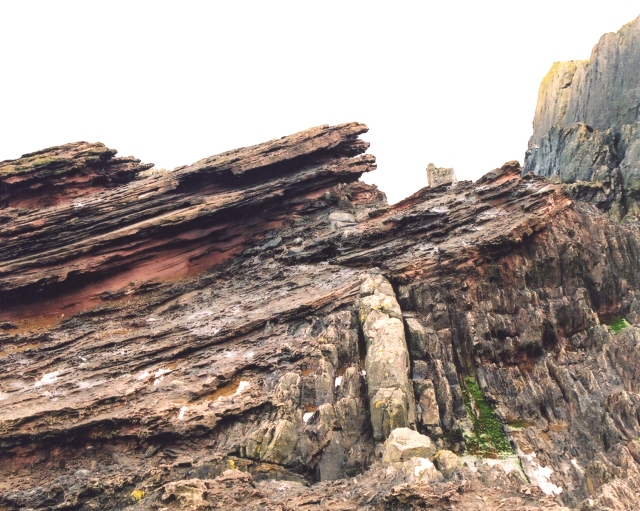The Backbone of Stratigraphy
Steno (1638 – 1687)
Steno gave geology an integral technique for the study of stratigraphy and, therefore, the development of the geologic time scale. Again, his ideas may have been assumed and used already, but he compiled and conveyed the process for future geologists. He recognized that rock layers are deposited in a systematic chronological manner with the oldest rock necessarily being below younger rocks. Deposition cannot occur underneath a rock layer that formed earlier. Analogously, intellectual leaps cannot be made without a solid starting point. He also stated that layers are deposited in a horizontal and continuous manner to whatever boundaries lay in close proximity. His law of superposition laid the groundwork for the relative dating of Arduino, Werner, Hutton, and Smith.
Arduino (1714 – 1795)
Arduino used the terms Primary, Secondary and Tertiary to describe layers and types of rocks. His classification used strictly lithological descriptions. Each classification described rock types without attempting to establish an absolute time when these rocks may have been deposited. He helped initiate the use of such categories for future geologists and future geologic columns.
Werner (1749 – 1817)
 Werner and Neptunism (catastrophism) – Neptunism describes the rock layers as being precipitated out of an all-encompassing sea. The receding water formed the rocks, mountains and valleys. The argument for Neptunism begs the question of where all the water may have gone, or even where it all came from. Regardless of the validity of such an explanation, Neptunism maintained its place as the accepted view of creation because it had theological and, therefore, logical appeal. Werner, an influential and persuasive geologist of the late 18th century, supported this hypothesis giving the idea credibility. Later investigation led to the dismissal of Werner’s theory.
Werner and Neptunism (catastrophism) – Neptunism describes the rock layers as being precipitated out of an all-encompassing sea. The receding water formed the rocks, mountains and valleys. The argument for Neptunism begs the question of where all the water may have gone, or even where it all came from. Regardless of the validity of such an explanation, Neptunism maintained its place as the accepted view of creation because it had theological and, therefore, logical appeal. Werner, an influential and persuasive geologist of the late 18th century, supported this hypothesis giving the idea credibility. Later investigation led to the dismissal of Werner’s theory.
Werner classified his rocks with minimally descriptive names. He used the terms primitive, transition class, Flötz, and alluvial to describe layers. Werner’s classification system continued to be largely lithological but with an order he claimed to be universal. Primitive denoted the first-formed rocks, with the transition class coming next; both chemical precipitates. Then Flötz followed, similar to the Flötzgebirge Lehman used to describe the sediments deposited from the sea. Finally, the alluvial deposits comprised a composite of the eroded bits of previously deposited rocks. He based the order of his geologic succession on a very small data sample, as he did not travel far to make or confirm his assumptions of universality. Therefore, his relative timescale seems rather arbitrary. While his assertions stood for quite some time, detractors questioned his ideas and they were eventually abandoned. As previous geologists had done, he used a relative timescale for his succession, not an absolute timescale. His contribution was to try to define a succession of rocks, a timeline for their creation that had not been attempted before.
- Primary – crystalline rocks (includes schist, gneiss and highly folded rocks)
- Secondary – hard stratified rocks without ores but with fossils (limestones, marls and clays containing fossils)
- Tertiary (Paleocene – Pliocene) – weakly consolidated stratified rocks usually containing numerous shells of marine origin, includes volcanic (youngest strata containing highly fossiliferous rocks, perhaps originating from secondary rocks)
- Quaternary (Pleistocene – Holocene) – alluvium
Hutton (1726 – 1797)
Hutton and uniformitarianism (Plutonism) – The world had become rational and mathematical. Bearing this in mind, Hutton correlated natural processes he witnessed with structures within, and general observations of, rock formations. These processes – erosion, deposition, volcanic activity, etc – take time to mold Earth’s surface. Therefore, Earth must be the result of a long series of gradual, consistently observable, processes.

Although Hutton’s ideas explained the creation of Earth more or less correctly, his observations led him to the erroneous belief of an unending time scale. He said as much when he wrote that he saw ‘no vestige of a beginning, no prospect of an end.’ Of the observable processes, none could explain how the Earth began nor how it might cease to be. Uniformitarianism grew from his logical approach along with his assertion that no evidence for a universal flood existed.
William Smith (1769 – 1839)
Smith took an important leap for stratigraphy. He studied the island of England and created or developed a detailed geologic map of Scotland, England, and Wales. His map included a geologic column showing, again, the relative ages of the rock layers, not an absolute time scale. He used fossils and lithology to relate the rocks and give them their place in the geologic column. His map describes the area with a degree of accuracy that is remarkable because of its originality and completeness. The geologic history of Britain had been described in its entirety up to the ability of the geologists, aided by laymen, of the time. His methods were necessarily more primitive than modern methods. His techniques, in general, were also more primitive but were used as building blocks for further research of England and stratigraphy in general. His map of England helped geologists also become cartographers.
Arthur Holmes in 1913 created the first timeline with the ideas and use of radiometric dating. Originally, dating was relative: this rock is older than that rock, but younger than the rock below it, using Steno’s ideas of superposition. With the advent of radiometric dating, geologists can give an absolute time to the rock layers. Radiometric dating uses the observable and consistent rate of decay of radioactive elements, expressed as half-lives. Many minerals contain some radioactive elements. Through calculating ratios of the radioactive elements compared to the nonradioactive elements, geologists can ascertain at what time the mineral formed. Geologists can correlate rock layers across vast distances by the similar fossils interred in the rock, in a broad, more general sense, as well as by the more precise radiometric date determined for the rock. With these techniques, a better definition of each of the geologic time scale delineations can be determined. The Silurian lasts from this year (443.7 Ma) to that (416.0 Ma). Radiometric dating aids in making the time scale more quantitative by better defining the geochronology and chronostratigraphy of a rock column.


